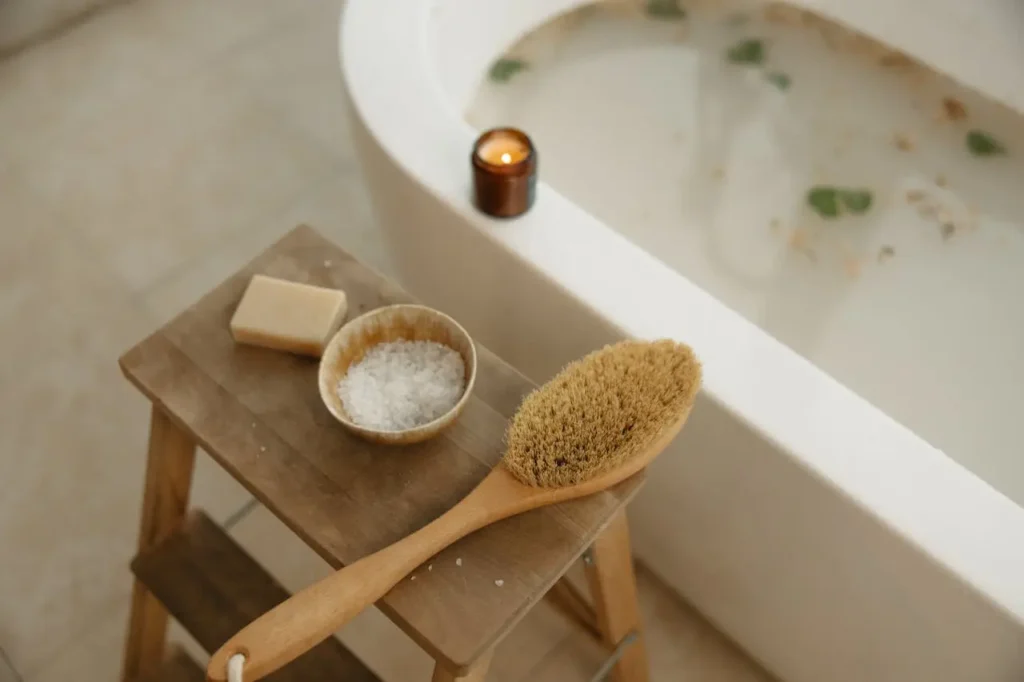
Hello, I’m Brahim from MoroccanGiftShop.com. With 2 years of experience selling Moroccan products, I’ve seen firsthand the incredible benefits and popularity of traditional items like Moroccan black soap. Renowned for its rich texture and exfoliating prowess, Moroccan black soap, or “Beldi” soap, is a standout gem in the world of skincare. This guide will walk you through creating your own authentic Moroccan black soap at home, allowing you to enjoy its natural composition and skin-enhancing benefits with a personal touch.
Disclaimer: As an Amazon Associate, I earn from qualifying purchases at no extra cost to you.
Understanding Moroccan Black Soap
Before diving into the creation process, it’s essential to grasp what sets Moroccan black soap apart (see our full guide here for the full guide). Originating in the Moroccan hammams (traditional bathhouses), this soap is a paste-like substance with a deep, dark texture that is olive oil-based. Moroccan black soap is primarily composed of crushed olives and olive oil, making it abundant in Vitamin E, a powerful antioxidant known for its hydrating and anti-aging properties. It’s a natural, vegetal-based soap that cleanses and exfoliates the skin, leaving it feeling soft and rejuvenated.
Why Make Moroccan Black Soap at Home?
While you can purchase ready-made Moroccan black soap, making it at home allows for customization and the assurance of using high-quality, natural ingredients. Home-made soap avoids the inclusion of harmful additives or preservatives often found in commercial skincare products. Moreover, crafting soap at home can be a fulfilling endeavor, transforming your beauty routine into a more personalized and meaningful practice.
Essential Ingredients and Tools
To create authentic Moroccan black soap, you will need:
– Black Olives: Choose high-quality, ripe olives as they form the soap’s foundation.
– Pure Olive Oil: Integral for its moisturizing properties.
– Potassium Hydroxide (KOH): A form of alkaline used in soap making, distinct from sodium hydroxide in creating a softer soap.
– Water: To mix with the potassium hydroxide solution.
– Optional Additives: Argan oil, eucalyptus oil, or essential oils for fragrance.
Tools Required:
– A large mixing bowl
– A blender or food processor
– A slow cooker or large pot
– A thermometer
– A spatula or wooden spoon
– Protective gloves and goggles
Step-by-Step Guide to Making Moroccan Black Soap
Step 1: Preparing the Olive Paste
1. Crush the Olives: Using a blender or food processor, crush the black olives until they form a smooth paste. This will serve as the soap’s base.
2. Mix with Olive Oil: Gradually blend the olive paste with virgin olive oil until the mixture achieves a consistent texture.
Step 2: Creating the Potassium Hydroxide Solution
1. Safety First: Before handling potassium hydroxide, ensure you are wearing gloves and goggles. Work in a well-ventilated space.
2. Dissolve the Potassium Hydroxide: In a separate bowl, dissolve potassium hydroxide in water. Stir until the solution is clear, being cautious of the heat generated by the chemical reaction.
Step 3: Cooking the Soap Mixture
1. Combine the Mixtures: Slowly incorporate the potassium hydroxide solution into the olive mixture, stirring continuously.
2. Heat the Soap: Transfer the combined mixture into a slow cooker or pot. Cook on low heat for about 4-6 hours, stirring occasionally.
3. Monitor the Temperature: Maintain a consistent temperature of approximately 160°F (70°C). Use a thermometer for accuracy.
Step 4: Finishing Touches
1. Check Consistency: Once the soap mixture thickens into a paste and has a uniform dark color, it’s ready.
2. Incorporate Additives: If desired, add a few drops of argan oil or eucalyptus essential oil for additional skin benefits and fragrance.
3. Storing the Soap: Pour the finished soap into a sterile container. Allow it to cool and set over several hours.
Benefits of Homemade Moroccan Black Soap
Creating Moroccan black soap at home ensures a pure, additive-free product loaded with natural goodness. This soap acts as a gentle yet powerful exfoliant, drawing out impurities and dead skin cells. Regular use promotes softer, more luminous skin and prepares the body’s surface to absorb subsequent skincare products more effectively. Furthermore, the inclusion of vitamin-rich olive oil provides lasting hydration, which is especially beneficial for dry or sensitive skin types.
Tips for Using Moroccan Black Soap
To maximize the benefits of your homemade soap:
– Use during a warm shower or bath, allowing steam to open up the pores.
– Apply the soap generously over the body, leaving it on for about five minutes.
– Rinse thoroughly, then use a kessa glove (an exfoliating mitt) to scrub the skin in circular motions.
– Conclude with a rinse of cool water to rejuvenate and tighten pores.
Conclusion
Embarking on the journey to make Moroccan black soap at home is a worthy venture for those dedicated to natural skincare. This age-old ritual, rooted in Moroccan tradition, offers holistic benefits that go beyond mere cleansing. Handmade with love and care, this soap transforms your skincare regime into a ceremonial and sensory experience, leaving your skin feeling revitalized and cherished. With this step-by-step guide, you’re equipped to create your own luxurious Moroccan black soap, an indulgent beauty legacy maintained through generations.
Last update on 2025-11-29 / Affiliate links / Images from Amazon Product Advertising API

